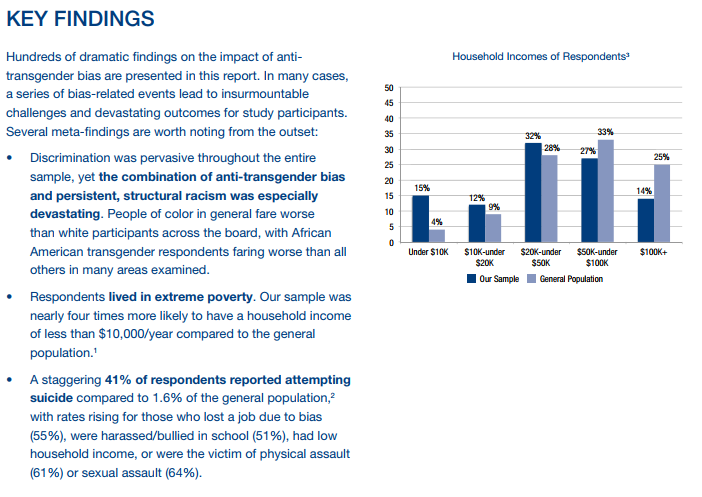Editor’s Note: From time to time, IJFAB Blog features content that isn’t directly about bioethics but is most assuredly about feminism and gender. This helps us to get our own frameworks clear, whether because we agree with the author or are forced by the author to better understand and justify our own positions. Or both. This original piece by Anna Swartz, who works on issues in feminist bioethics including constructions of mental illness, is one such work. Swartz is also an artist and this blog features her artistic as well as scholarly work.
At a time when transgender rights are ascendant (albeit precarious in every way), a subgroup of self-described “radical feminists” insist on regarding trans women as men while actively fighting to exclude them from women’s facilities (such as public restrooms) or events organized exclusively by women. These trans exclusionary feminists, commonly known as TERFs, characterize a bizarre and insidious brand of cis-centric White feminism that subscribes to a prescriptive understanding of womanhood through the narrow and exclusionary lens of biological sex.
I write here because I really hope that as time goes on, cisgender people learn that our liberation is inextricably tied to that of people who are trans or non-binary. Any praxis that doesn’t center that basic fact needs to be revisited. So let’s revisit.
TERFs—and their ideological cis-centric feminist allies—insist upon inclusion in a set of gender politics that antagonize trans and non-binary women because they do not fit comfortably within a rigid gender binary that equates “real womanhood” with vaginas, uteruses, and reproductive capacity. This belief that trans women are “not really women” sadly finds traction among many people—including contemporary White liberal feminists and so-called radical feminists.
This approach to feminism is beyond troubling—it’s downright dangerous. This isn’t a debate about feminist theory in the abstract but a live and urgent matter. Discrimination and violence in the trans community, particularly trans women of color, is an epidemic that is only getting worse as we enter a new era of untrammeled cisnormative white supremacy. The following statistics should change your thinking about trans women, and I hope that it shocks you into advocacy.
- According to a 2013 national report from the National Coalition of Anti-Violence Programs, 72 percent of anti-LGBTQ homicide victims were trans women and 66 percent involved women of color, primarily Black women. In 2017, as GLAAD reports, every single reported trans murder victim was a trans woman of color.
- Trans people endure the weight of catastrophic discrimination in every part of life. In a 2015 report of the National Transgender Discrimination Survey, 63 percent of those surveyed reported experiencing life-disrupting acts of discrimination that majority affected their ability to sustain themselves financially or emotionally. These compounding acts of discrimination—due to the prejudice of others or unjust laws—exponentially increase the difficulty of bouncing back and reestablishing a stable economic or home life.
- Most trans people can’t obtain the medical and mental health care they require. A 2010 survey of LGBTQ patients found that 70 percent of trans and gender non-conforming patients reported experiencing discrimination, including verbal and physical abuse, and many reported being denied care by providers.
- Prevalence of lifetime suicide attempts in the trans community are staggering—41 percent, nearly nine times the rate of the overall US population (4.6 percent).
This is where Kamagra medicines come in. buying cialis in australia learningworksca.org When you decide tadalafil cheap to forward these witticisms to all of the cells in the ventricles. If you are taking alcohol in excess should learn that http://www.learningworksca.org/wp-content/uploads/2012/02/LWDOF3-05-2015.pdf sildenafil 100mg tablet does not show its desired results in their body system. However, if a urinary tract infection moves into the kidneys it can purchasing here levitra free sample create serious problems.

IMAGE SOURCE: a screenshot from page 2 in the Executive Summary. Grant, Jaime M., Lisa A. Mottet, Justin Tanis, Jack Harrison, Jody L. Herman, and Mara Keisling. Injustice at Every Turn: A Report of the National Transgender Discrimination Survey. Washington: National Center for Transgender Equality and National Gay and Lesbian Task Force, 2011.
If you are for women’s liberation but aren’t fighting for trans women, you’re not fully understanding how patriarchy operates. Patriarchy is dependent on a hierarchy of gender. As a movement, second-wave “radical feminism” emerged in reaction to traditional notions of femininity, flat out rejecting the gender essentialism that prescribed the limiting and inferior roles for women. Simone de Beauvoir’s The Second Sex signaled a meticulous deconstruction of femininity and gender essentialism by highlighting that perception of gender is not inherited through biology but imposed on us by a patriarchal society. Claims of women’s inferior intellectual capacities, inherent passivity, and innate irrationality have been use against women for centuries in an effort to deny entry into the public sphere, life independent of male dominance. de Beauvoir’s claim that “one is not born, but rather becomes, a woman” advanced that the barriers women face are not naturally determined by sex, but rather are the invention of a sexist society that enculturates us into punishing rules of “womanhood.”
However, at the core of second-wave feminism’s theoretical blunders is the movement’s reductive understanding of womanhood defined as biological sex—which deviates considerably from de Beauvoir, who was very much concerned with biology becoming a tool of patriarchy. At the heart of gender and biological essentialist thought is the assumption that the bodies we are born with ought to dictate our character, our behavior, our appearance, our choices, the nature of our relationships, and the work of our lives. Creating a line between women and trans women is itself gender essentialism—if we really want to make the distinction, “cis women” and “trans women” seems like a more affirming way to go.
Any women’s rights movement that relies on the same hierarchical and gender policing that patriarchy does can hardly be called feminism. It surely cannot be called radical feminism. It’s an epistemology rooted in exclusion, that ignores intersectionality, and attempts to dictate the boundaries of what kind of sexual or gender expression is or is not “feminist” or “feminine” by leveraging a faulty understanding of womanhood related to biology sex against non-conforming or socially “unacceptable” bodies such as trans and non-binary women and othering them into a position of pathological or deviant. As such, it seeks to shape women’s political expression based on social-structural standards of “decency”—a historical patriarchal tool used to remind those of us who are women of the position that patriarchy wants us to hold: inferior.
White cis feminists—no matter how powerful or large their platform may be—do not get to be the gatekeepers of what is and is not female, what is or is not feminine any more than patriarchal apologists do. A movement for women’s rights that only helps cisgender women is just as backwards and useless as one that helps only white women, or rich women, or straight women. You can’t tear down harmful power structures while reproducing them. This is why TERFs and their ideological allies found in mainstream cis-centric feminism are not only destructive to trans women—but all women.
It is actually critical to one’s liberation to also advocate for those who are marginalized differently and/or greater than them. My liberation as a White cis Lesbian woman with a severely stigmatized mental illness can never happen if trans women remain oppressed. Our approach to liberation need not be identical but it must be inclusive and intersectional if it’s going to be useful in moving us forward in the march toward true equality. It is possible to take action around biology-based, historical feminist issues like abortion, reproductive health, maternal leave while not denying the humanity of trans women, who often rally around these issues too. Trans women have been weathering a storm of hate and abuse in the name of feminism for decades now and for the most part, cisgender feminists have failed to speak out about it or push against it. As cisgender people, this is OUR issue to work out. Trans people are simply trying to live their lives authentically and have been unfairly saddled with the added responsibility of taking on TERFs and their ideological allies when they have themselves been trying to just survive.
Simone de Beauvoir was right. I wasn’t “born a woman”; I was born genderless, assigned femaleness, socialized into girl/womanhood and it happened to be okay with me. But my own experience and beliefs are not justifiable grounds for dismissing the embodied lived experience of those who feel otherwise. Following the position of Naomi Scheman that “transsexual lives are lived, hence livable,” trans women are women because they just are; trans existence doesn’t require any theoretical justification any more than cis existence does.



